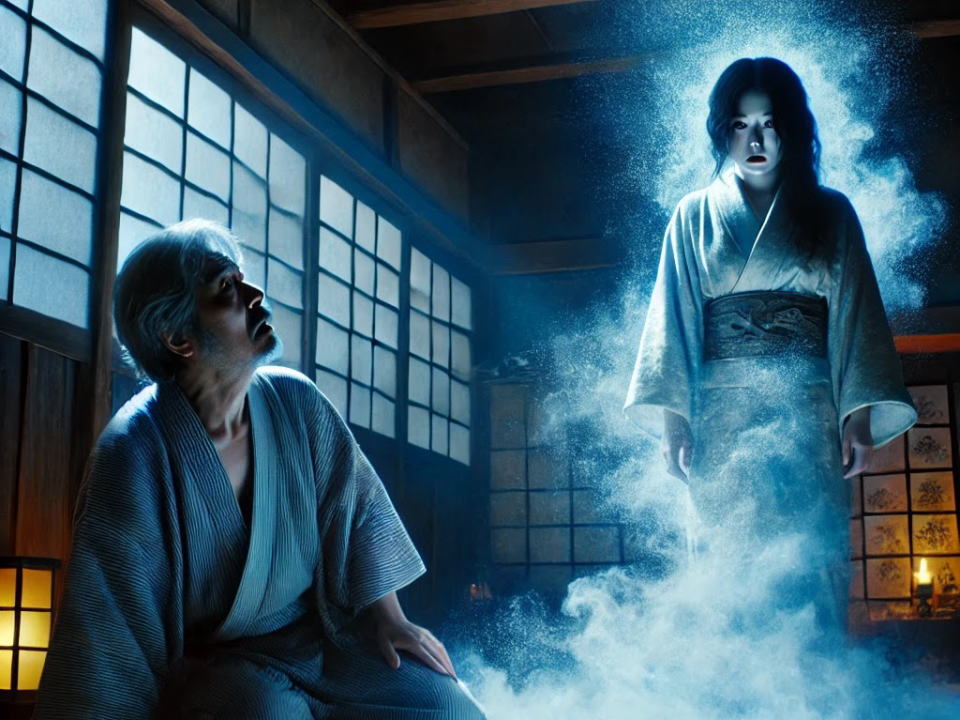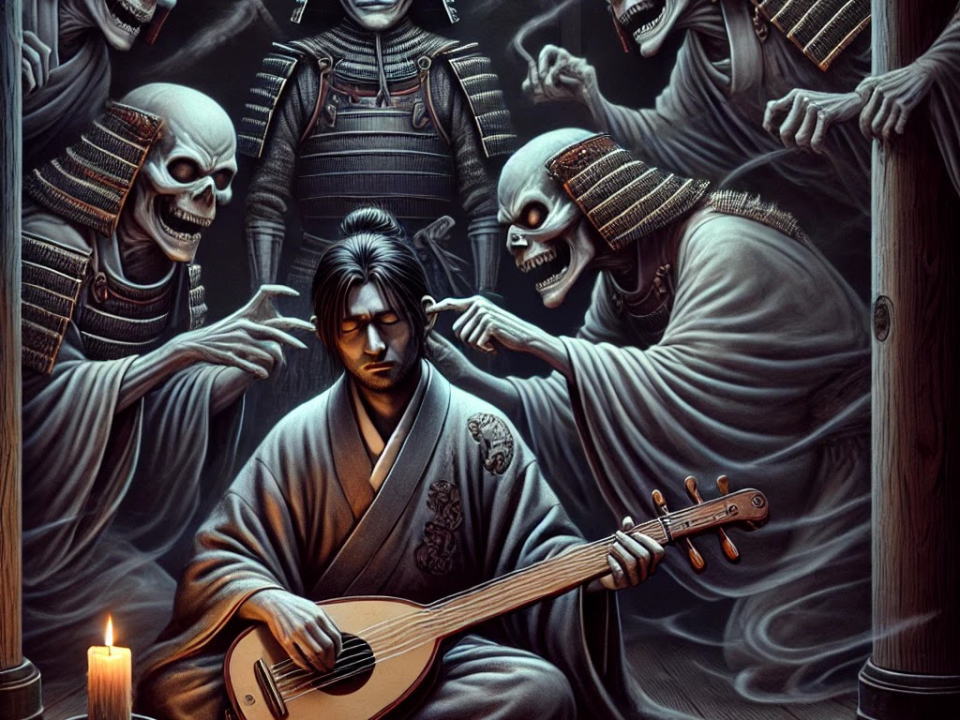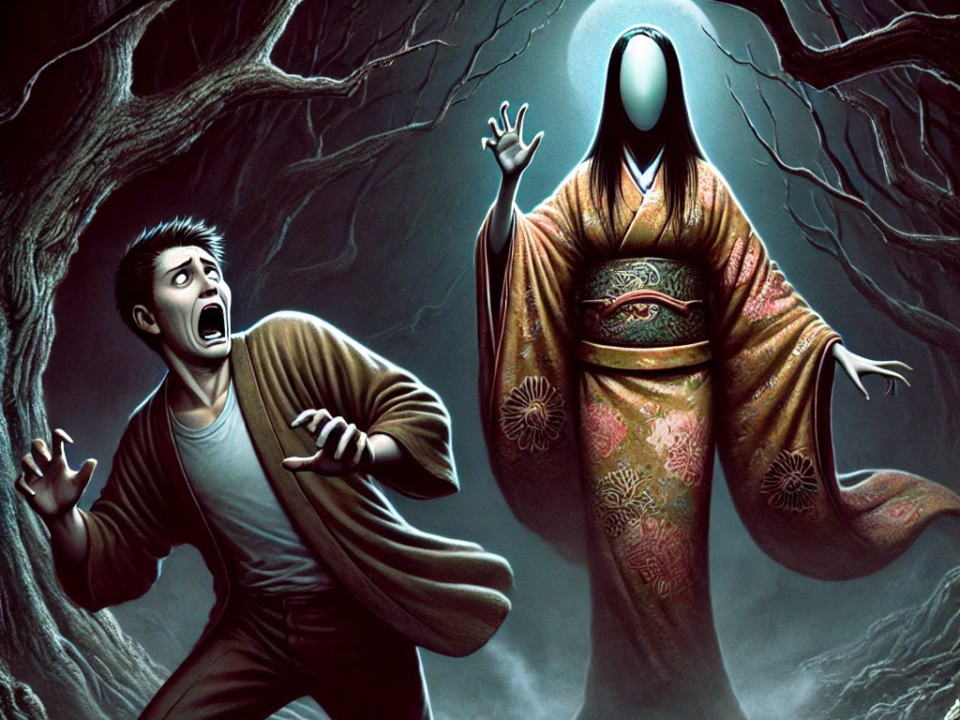Lafcadio Hearn’s Kwaidan is a groundbreaking work that introduced traditional Japanese ghost stories and folklore to the Western world.
Published in 1904, this collection features eerie tales from various regions of Japan, captivating readers with its unique atmosphere.
In this chapter, we will explore some of the most famous stories from Kwaidan and uncover their haunting allure.
1. Yuki-Onna – The Silent and Icy Terror

Yuki-Onna (The Snow Woman) is a story about a mysterious spirit associated with snowstorms. Hearn retells this classic Japanese folktale with a fresh perspective, making it more accessible to Western audiences.
Summary
One winter night, a woodcutter and his son, Minokichi, are caught in a fierce snowstorm and take shelter in a mountain hut.
As the night deepens, a beautiful woman appears and freezes the father to death.
However, she is moved by Minokichi’s youth and spares his life, warning him never to speak of this encounter.
Years later, Minokichi meets a beautiful woman named O-Yuki and marries her.
They build a happy life together, but one evening, Minokichi recounts the story of Yuki-Onna to his wife.
O-Yuki’s face turns cold, and she tells him, "You have broken your promise." Then, she vanishes like melting snow.
The Story’s Appeal
The Importance of Promises and Taboos: The central theme revolves around the consequences of breaking a vow.
The Contrast Between Beauty and Terror: Yuki-Onna is portrayed as both mesmerizingly beautiful and terrifyingly cold.
The Expression of Impermanence: The story embodies the Japanese concept of mujo (impermanence), highlighting life’s fleeting nature.
2. Mimi-Nashi Hōichi – The Tragic Tale of a Blind Biwa Player

Mimi-Nashi Hōichi (Hōichi the Earless) tells the eerie story of a blind biwa (lute) player who becomes entangled with the spirits of the dead.
Summary
Hōichi, a blind musician, is invited each night to perform for the spirits of the fallen Heike clan.
His mesmerizing performance pleases the ghosts, but his fellow temple monks realize the danger he is in.
To protect him, they inscribe Buddhist sutras all over his body, rendering him invisible to the spirits.
However, in their haste, they forget to write on his ears.
That night, the spirits come for him but can only see his ears.
They tear them off and depart, leaving Hōichi in agony.
Despite his injuries, he survives, realizing he has narrowly escaped a ghostly fate.
The Story’s Appeal
A Blend of History and Horror: The spirits of the Heike warriors add a historical depth to the supernatural tale.
The Persistence of the Dead: The relentless pursuit of the ghosts adds an eerie inevitability to the story.
The Role of Religion and Ritual: The Buddhist sutras serve as a spiritual shield, emphasizing the significance of faith in Japanese culture.
3. Mujina – The Fear of the Unknown

Mujina is a short yet striking tale that delivers an unsettling psychological horror experience.
Summary
A man walking along a lonely road encounters a woman weeping by the roadside.
Concerned, he approaches and asks what is wrong.
When she raises her face, he is horrified to see that she has no features—just a smooth, blank surface.
Terrified, he flees to a nearby tea house and recounts his ordeal to the shopkeeper.
The shopkeeper listens calmly and then asks, "Did she look like this?" before revealing his own featureless face.
The Story’s Appeal
Minimalist Horror: The simplicity of the narrative enhances its psychological impact.
Ambiguity and the Uncanny: The noppera-bō (faceless ghost) blurs the line between human and supernatural, creating unease.
A Reflection of Japanese Cultural Fears: The fear of deception and uncertainty resonates deeply in Japanese society.
Conclusion
Lafcadio Hearn’s Kwaidan preserves Japan’s rich tradition of ghost stories, each reflecting profound cultural values and beliefs.
Through these tales, we see that Japanese ghost stories are more than just chilling narratives—they explore human emotions, moral lessons, and religious symbolism.
Thanks to Hearn’s work, these stories have reached a global audience, influencing countless films and novels.
The transient beauty of Yuki-Onna, the sorrowful fate of Mimi-Nashi Hōichi, and the eerie simplicity of Mujina continue to haunt and fascinate readers even today
References
https://www.hearn-museum-matsue.jp/ (Lafcadio Hearn Memorial Museum)
https://www.kankou-matsue.jp/ (Matsue City Official Tourism Site)
https://www.jnto.go.jp/ (Japan Government Tourism Office)
